Go to the final entry on this page .....Go to previous entry18 June - A busy weekend has just passed - a combination of work in the garden and being with grandchildren for Father's Day. The latter was especially enjoyable, and the former was rewarding, if not finished yet. I've finally been able to dispense with the the ugly wooden support around our old Ivy tree, having removed another foot or so of the old tree. That now stands between 5 - 6ft tall, depending where you stand(!) and is supported discreetly by a steel post hidden behind it. I have decided not to remove it completely, but to use it as a feature, allowing the Ivy to continue growing over it. Once other tasks around it are complete I will cap the top of it and then drill into it to create a nesting space that may tempt a Wren in the future. I now need to head for our local garden centre to buy a lattice panel to put up behind the stump, and a smaller one to install to one side of it. Last month my neighbour had a new fence installed between our gardens. The cement around the bases of the concrete posts has now had plenty of time to set so with my neighbour's permission, on Saturday I drilled a small hole in each post and attached aluminium hooks (using brass screws) to support the bundle of cctv cables that link the house with the bird boxes at the bottom of the garden. And today - apart from a few photographs it's been a day off!
Since finding those small spiders (Theridion pallens) with their pointed egg cases I've been monitoring them daily, and I realised that while there are photographs of all four spiders I had only photographed one of them with its egg case, so today I'm correcting this.
In each case spider and egg are both close to a leaf vein but on opposite sides of it, and they are less than 1 cm apart.
The images have been rotated for the sake of convenience, but on the tree three of the spiders are positioned almost vertically above the egg case, the other one being level with the case. As far as I can tell the spiders have maintained these positions of the last few days. All of the spiders are on the undersides of leaves, and three are between 1.5 - 1.65m above the ground. The only exception to this is the spider that I accidentally detached from the tree and then replaced, and its original leaf was in the same height range as the other three are. Today I have spent ages checking all the other low branches on the Birch, up to a height of around 2.5m without seeing any other examples. Neither could I find any on the Hazel or Rowan leaves. No more about these spiders until the eggs hatch (unless I find a male!).
Also, this species is very agile, running very quickly to chase prey or escape, as this one did as soon as I touch the leaf it was on! The male looks very different - slightly smaller and with its upper body a dark chocolate brown colour with a light edging.
I first spotted these on Saturday morning (16th)while checking on the spiders, on the underside of a Birch leaf about 1.5m above the ground. Looking like tiny grapes they may well have been laid by a Green Shieldbug (Palomena prasina).
While they appear smooth and shiny, a closer look reveals a textured surface. Also, notice the rings of light coloured spots (ignore the white crescents - these are reflections from my ring flash). If I'm correct about the eggs, the rings mark the position of the 'trap-doors' that open as the nymphs emerge. Hopefully I'm be around when this event occurs.
It must have flown in through an open window during the afternoon, or hitched a ride on my shirt. However, it has disappeared again, so it will have to wait until tomorrow to be released back into the garden.
19 June - A better day weatherwise with lots more sunshine for much of the day, although for most of the time I was too sleepy to enjoy it!
There was no sign of the shieldbug inside the house this morning but when I took a walk down the garden before breakfast I spotted this pair of Hawthorn Shieldbugs mating on the Rowan. As was the case with yesterday's example they exhibited bright, fresh looking colours.
While the foliage on the Rowan looks healthy, I'm afraid that 2012 is going to be a failure as far as berries are concerned. It seems that the tree flowered during the worst of the weather we experienced last month, and I can see no sign of any berries developing. On the Elder the situation is not quite so bad. A handful of the early flowers look as though they were pollinated, and with some inflorescences still opening we should end up with some berries. Back to the little spiders for a moment - First, I've added a fifth example to yesterday's set of spiders with egg cases.
Next, while the females stand guard over their egg cases they are not choosing to fast, and as this picture shows, some of the silk around the egg case must be capable of trapping insects.
A micro-moth on the Stinging Nettles - I've been told that the guide book is on its way!
And at last a native 10-spot Ladybird, seen on the roses at the front of the house, just the one amongst hundreds of aphids! Below it, the capsid bug is probably a Tarnished Plant Bug (Lygus rugulipennis). This is a very common species.
20 June - A pleasant day outside, but I continue to pay the penalty for too much action over the last week or so. Just one photograph today, to record a second native ladybird on the roses, this time a splendidly bright 7-Spot Ladybird. Two ladybirds in two days is an improvement, although I would far prefer to be reporting on two dozen!
21 June - A disappointing day with cloud, gusty winds and frequent spells of drizzle or light rain, and a high of 17C - not what you would want on the longest day of the year. There was a bright spot when the postman delivered the 'Field Guide to the Micro-moths of Great Britain and Ireland', a very nice companion to the excellent Moth Guide, illustrated by the same person.
The guide gives its ID as Argyresthia brockeella . Just over 5mm long, this is a species that relies on Birches and Alder as a food plant for its larvae. Eggs are laid in buds in the Autumn and then overwinter in male catkins. Next Spring I shall have to watch out for distorted catkins. I've included these two images as they show how much difference a slightly altered lighting angle makes to the moth's appearance.
Later in the day I spotted what may be the same individual on a Birch leaf, and was able to get a bit closer, and on the other side.
And now a mystery - this morning I took this picture of the eggs on the Birch so that I could check for any visible changes since I last photographed them. They appeared unchanged.
In this trio of images I've shown the area before and after their disappearance. I can understand if the eggs have been eaten, but why no remains left? What would have eaten the whole clutch? Could it have been a Harlequin Ladybird?
I searched all the nearby branches but found no Ladybirds. Other than the spiders that I'm watching, the only predator I found was this Lacewing larva, a couple of leaves away. A predator of aphids, I don't see how this individual would have devoured the eggs.
22 June - If it weren't for all the green foliage, this could be a damp autumn morning, with grey (albeit quite bright) skies, and a fresh breeze - around 23mph from the SW recorded at Farnborough between 8 - 9am. Later in the day the breeze eased and we had a afternoon of very heavy showers with occasional bright spells - the hosepipe ban continues!
23 June - I will add the large images for this entry as soon as I can A pleasant morning, with our grand-daughters here for a couple of hours during which we were able to spend time outside in sunshine - the sand pit was uncovered for the first time in weeks. I'll start today's entry with an update on the spiders with pointed egg cases. Two of the spiders have now disappeared. While the egg case of spider 3 is still in position, in the case of spider 1 (see large image of 18 June) both spider and egg case have disappeared. As I've already discovered, the females are quite capable of moving the cases, so she could have decided to move it elsewhere. I've checked all the leaves near to the original position by so far I've failed to find them.
Back on the 19th I spotted this small sawfly larva curled up on another low hanging branch of the Birch tree. It remained in this position, on the underside of a leaf, all day suggesting that it is a nocturnal feeder.
I have been able to find it on the same branch each day since, although not always on the same leaf. This is it on the 21st, with a scale added, and looking rather plumper, although I cannot see which leaves it has been feeding on.
And this is it yesterday, coiled clockwise this time, and on a different leaf. Tonight at just before 10am it was still coiled up. I had hoped to check again at 10.30pm but by then it was raining quite heavily - perhaps tomorrow night I'll try again to find where it feeds.
A very different form of young insect, this is a nymph of a bug and one I regularly find on the Elder. A boldly marked nymph, but I've yet to confirm its identity.
Finally, back to spiders, this time a pair under a Hazel leaf.
The silk over (or rather under) the female is covered with droplets of liquid. I don't think this can be rain water as there had been no rain prior to my taking the photograph. Could they be honey dew from aphids occupying the same leaf? Would the spiders not catch these?
Here is the female, appearing to measure some 4mm in length, although I'd like a chance to photograph her 'out in the open' to be sure of this.
I was surprised to see how much bigger the male is than the female. He is around 4.6mm long, and with very long legs. The pair remained in the same positions all day, but at approaching 10pm the male is now outside the silk canopy. The female had also left her sanctuary but as soon as I moved the leaf she returned to it.
After searching through my Collins spider guide I think that the pair are of the species Enoplognatha ovata, a common species (sometimes found with red stripes on the abdomen). Females can be in the size range 4 - 6mm and males 3 - 5mm, so the combination I've recorded is possible. The guide notes that in summer the female produces a bluish egg sac which she guards under a leaf that is often slightly rolled using silk - I shall be checking for this in the days to come.
25 June - A very pleasant summer's day with the temperature in the twenties - officially 21C but more like 25C in the sheltered garden. For me it was one of those dreamy days after spending much of yesterday atop my tall stepladder giving our Hawthorn a 'haircut'. I needed to repair my extending pruner after that job, so at least I did achieve something today.
Even with summery conditions today I didn't see a single butterfly pass through the garden, which was very disappointing, although there was the occasional flash of brightness from around the Burberis when this Yellow Shell moth (Camptogramma bilineata bilineata) was disturbed as I tested the pruner.
This afternoon I spotted this Wool Carder Bee (Anthidium manicatum) feeding at White Dead-nettles. I've only seen this species here twice before, in 2007 and 2009. It is a leaf-cutter bee, and its common name comes from the female's collecting of 'down' from plants to line her nest cavity. The bright coloration of this individual suggests that it had only recently emerged.
In the meantime here is a much more visible female, on a Birch leaf this time (with no leaf folding having occurred). As the scale shows, this female is even smaller, at around 3.5mm body length, although the long legs are much more obvious, as are the dark bands on the tibiae of the front legs - similar to the male.
And at the end of the afternoon a pleasant surprise - an adult hedgehog out and about at 4.45pm. This is the first one I've seen in the garden this year. It was large and looked healthy. Unfortunately, in the couple of minutes it took me to get my camera it had disappeared!
Click on images to see larger versions
|
|
2012 Garden Diary Index..... .... ...Last Month..................July |
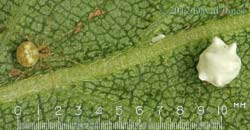
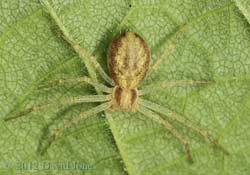
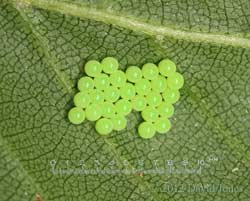
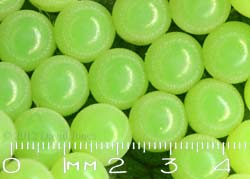
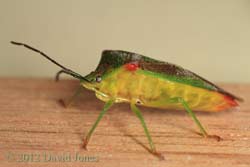
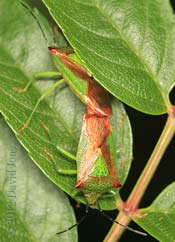
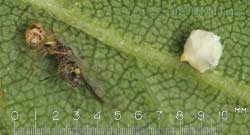
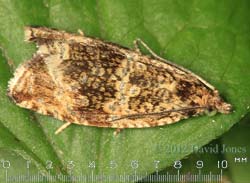
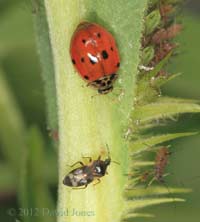
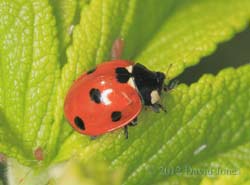
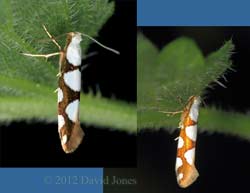
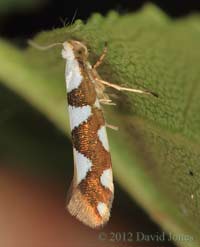
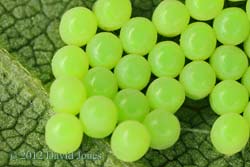
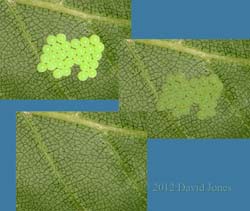
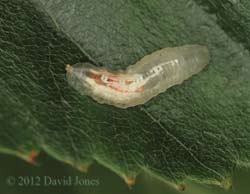
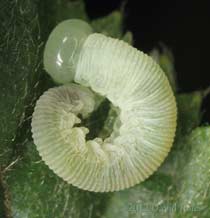
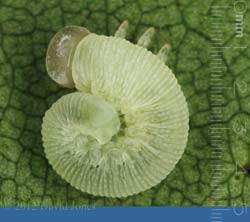
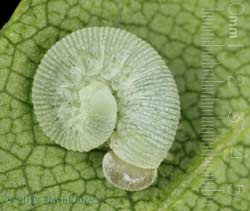
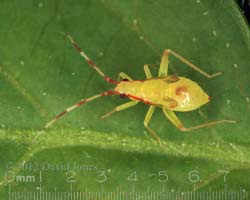
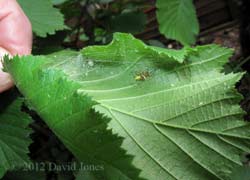 Here
I've needed to rotate the leaf through 180 degrees to show them. They
(especially the female) are protected by silk which has pulled the sides of
the leaf inwards, making it quite difficult to get a useable photograph of
the female (nearest to my hand).
Here
I've needed to rotate the leaf through 180 degrees to show them. They
(especially the female) are protected by silk which has pulled the sides of
the leaf inwards, making it quite difficult to get a useable photograph of
the female (nearest to my hand).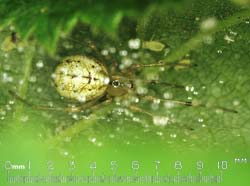
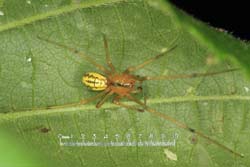
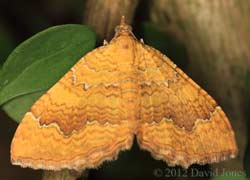
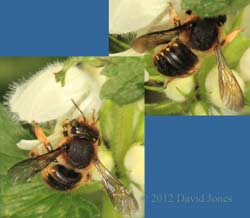
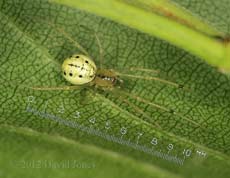 I
see that the male E. ovata
has now left the shelter of the folded Hazel leaf. The female is still well
hidden and there is no sign yet of her producing an egg case.
I
see that the male E. ovata
has now left the shelter of the folded Hazel leaf. The female is still well
hidden and there is no sign yet of her producing an egg case.